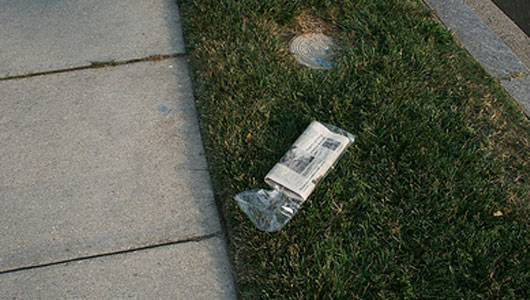This article is part of our “Leaders of the Future” series, featuring young activists in the neighborhood and surrounding areas. Author Diana Healy is currently a junior at Brooklyn Technical High School in the Environmental Science major, and a member of the Rockaway Waterfront Alliance.

Everyone has seen it, on either their own doorstep or their neighbor’s: the weekly newspaper in a plastic sleeve. Today, most people receive their news via online sources or from watching the news on TV. In fact, according to the Pew Research Center, only 16% of Americans rely on newspapers for news. Nevertheless, newspapers are still delivered every week to houses all across the country. In most parts of Brooklyn it’s fairly common to receive a newspaper full of coupons and other junk mail, often called “lawn litter”, that is rarely read. So why has this method of advertising not become obsolete?
Well, many argue that a ban on this practice would infringe upon our freedom of speech. In 1999, the Georgia Supreme Court in Atlanta ruled 6-1 that a Sylvania ordinance prohibiting distribution of free printed material to yards, driveways or porches violates freedom of speech and press under the U.S. and Georgia Constitutions. While citizens argued that these newspapers, or “penny-savers”, were a source of litter, the majority court felt that there were other ways to prevent litter that did not infringe on free speech or the press.
It’s likely that this same argument would be presented in New York City if a ban on involuntary newspaper deliveries were to be presented. As well as the argument that there are ways to opt out of the delivery, such as a “Do Not Place Unsolicited Advertisements on This Property” sign. However, these sign are often ignored. The other way to opt out is to contact the advertising company directly. This is often a major inconvenience and is why most people just endure the paper onslaught and throw out the newspaper once a week.

Right now, it seems that New York City will continue to receive these nuisances for years to come, but what kind of impact will this have in the long run? Since the plastic bags that contain the newspapers are non-recyclable, they will end up in a landfill. Not to mention the amount of paper wasted on printing all these newspapers: the carbon footprint of newspapers themselves, excluding the plastic, is hard to calculate due to the many ways that newspapers. At the highest end of the spectrum, purchasing seven bulky papers each week, all of them printed on typical paper stock and ultimately sent to landfill, could create as much as a tonne of CO2e each year.
One way to limit the damage is to replace the plastic sleeves with biodegradable sleeves. Biodegradable plastic bags break down in the environment. They inflict less harm ecosystems and contribute to landfills less than regular plastic bags. This change has already occured in places such as the UK. The Guardian, a national newspaper in the U.K., has replaced its polythene packaging with a compostable wrapper. The newspaper and its inserts are now packaged in a clear, biodegradable material made from potato starch that will completely compost in just six months. If New York can’t stop these newspapers from winding up on our doorstep, we should at least stop them from ending up in a landfill.


